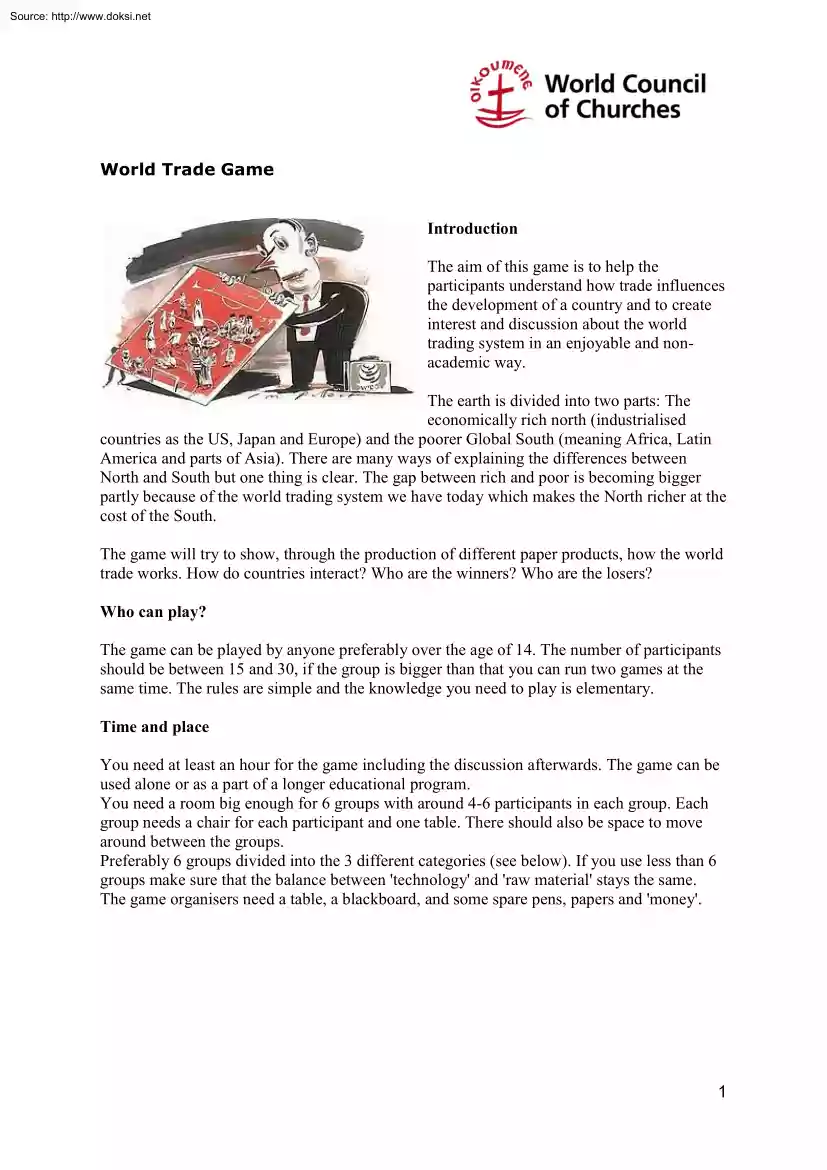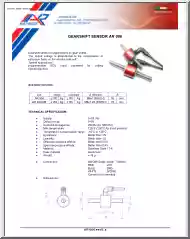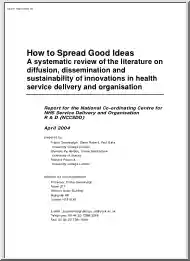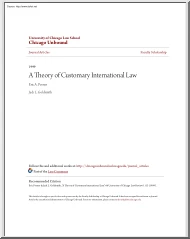Comments
No comments yet. You can be the first!
What did others read after this?
Content extract
Source: http://www.doksinet World Trade Game Introduction The aim of this game is to help the participants understand how trade influences the development of a country and to create interest and discussion about the world trading system in an enjoyable and nonacademic way. The earth is divided into two parts: The economically rich north (industrialised countries as the US, Japan and Europe) and the poorer Global South (meaning Africa, Latin America and parts of Asia). There are many ways of explaining the differences between North and South but one thing is clear. The gap between rich and poor is becoming bigger partly because of the world trading system we have today which makes the North richer at the cost of the South. The game will try to show, through the production of different paper products, how the world trade works. How do countries interact? Who are the winners? Who are the losers? Who can play? The game can be played by anyone preferably over the age of 14. The number of
participants should be between 15 and 30, if the group is bigger than that you can run two games at the same time. The rules are simple and the knowledge you need to play is elementary Time and place You need at least an hour for the game including the discussion afterwards. The game can be used alone or as a part of a longer educational program. You need a room big enough for 6 groups with around 4-6 participants in each group. Each group needs a chair for each participant and one table. There should also be space to move around between the groups. Preferably 6 groups divided into the 3 different categories (see below). If you use less than 6 groups make sure that the balance between technology and raw material stays the same. The game organisers need a table, a blackboard, and some spare pens, papers and money. 1 Source: http://www.doksinet Equipment For 30 participants you need: o o o o o o o o o 30 sheets of A4 paper in the same colour 30 100 $ notes 2 sheets of coloured paper
2 tubes of glue 2 pairs of compasses 4 pairs of scissors 6 rulers 2 triangles 14 pencils/ pens Group Categories country suggestions Category A USA Japan Number of Participant 4 4 Category B India Brasil 5 5 Category C Mozambique Tanzania 6 6 Distributed Resources Resource set A: 2 pairs of scissors 2 rulers 3 markers 2 compasses 1 triangles 1 sheet of paper 6 100 $ notes 4 pencils Resource set B: 10 sheets of paper 1 sheet of coloured paper 1 tube of glue 2 100 $ notes Resource set C: 4 sheets of paper 2 pencils 2 Source: http://www.doksinet Ready to Play? All participants must be able to see the models of the products they are producing (see below). Draw the models on the black board or on big sheets of paper The game needs three organisers: Two bureaucrats in the World Bank. The banks job is to quality check the products and write down all the deposits in the different bank accounts as well as adding 10% interest every 10 minutes. The games facilitator - UN. The
facilitators role is to lead the game, observe how things develop and sometimes change the development of the game by introducing new elements. Because the facilitator is also supposed to lead the discussion afterwards it might be helpful to write down everything that happens; comments, happenings etc. The Rules All products must have sharp ends, be cut by a pair of scissors and have the exact size. When you have produced 5 examples of one product you can present this to the Bank. If the quality is good enough the amount of money your products are worth will be written down in your bank account. Every 10 minutes the Bank will add 10% interest to the amount of money already in your account. You are only allowed to use distributed resources and equipment. You are not allowed to use physical force or violence. The facilitator, who represents the UN, will mediate in case of disputes between countries. Only what is already in your bank account when the game ends counts when the result is
summarised. Instructions for the facilitator Explain the aim and rules thoroughly. Answer questions but make it clear that you will not answer any questions when the game starts. Divide participants into 6 groups and give them their countries resources. In the beginning there will be confusion and youll get a lot of questions; "Why dont we have any markers?", "What is the coloured paper for?" Remember not to answer any questions. Make sure all the initiative come from the participants and not from you. The production and trading may last for 30-60 minutes, all depends on how interested the groups are, their activity and initiatives. 3 Source: http://www.doksinet What to produce? These are the 5 different products the groups can produce. When you have produced for example five triangles you go to the bank for quality check and if they are good enough you will get $150 x 5 = $750 into your account. For the Facilitator (important points during and after the game):
Notice everything that happens The category "A" countries will probably start producing goods at once but they will run out raw material (paper) quite soon. Then they will have to try and get hold of more paper from the other groups. Because you are the only one that can see how the game really develops it is important that you notice how alliances and trade conditions change throughout the game. Use your observations in the discussion after the game. Take notes Stimulate activity Sometimes the facilitators have to give additional information and try to create new situations. Some of the information can be given to the whole group while some information will be given secretly to some countries. Remember to inform the bank about all the changes you make. Not all the elements below need to be implemented in the game You have to see how the game develops and how much stimulation is needed. 4 Source: http://www.doksinet Some examples: o Price-changes on the global market
After a while you can change the price of some products. That way the rich countries for example will find out that their compasses are not as useful as they used to be. From this you can draw parallels to the real world: When a country finds out that their technology is getting out of date they usually sell it to poorer, less developed countries. The prices can also drop if there is an overproduction of one product on the market. (Like oil prices in the mid 80s) o Raw materials You can for example give a bunch of papers to one country and then announce for "the whole world" that a new source of raw material has now been found in this country. o The coloured paper Two of the groups have a coloured paper and some glue. They have no idea what to use it for. This represents an unknown natural resource You can make it known for two other groups, e.g: If you stick a little piece of the coloured paper on to your normal products the price of those products will increase 4 times.
These two countries will then start searching for the coloured paper and the glue. Because the country that owns it doesnt know the value of it they might sell it really cheap. (Like Zambia sold the rights to exploit and export copper to Rhodes in the late 19th century.) Or they get suspicious and wont sell it o Development assistance You might want to inspire a country or two by giving them some economic assistance from the UN, with conditionalities: 1/3 of what they produce with UN support must be paid back to the UN. You can also support a country with technology (e.g a pair of scissors) If you decide to support a country or one of the rich countries start supporting a poorer country, this can be used later to discuss the motives behind development assistance. o Import taxes A group of countries can make restrictions on trade with other countries to protect their own interests. E.g the EU have higher import taxes on treated goods than raw materials A couple of years ago the
import tax on fresh pineapples was 9%, on tinned pineapple the tax rate was 32% while tax on pineapple-juice was 42%. This way the EU make sure that the Third World countries keep on producing and exporting primary goods. 5 Source: http://www.doksinet o Trade restrictions and sanctions Both you and the different countries can set up either multi- or bilateral trading restrictions or sanctions. Examples from the real world: South Africa, Iraq, Cuba etc. Ideas for discussion Fair trade Some of the participants will probably get accused of cheating. That gives you the perfect chance to discuss moral issues and ethics in international business. "Its not fair!" Hopefully the participants will point out this fact quite early. After the game it is important to use this statement and together try to find out: o o o o o o o What was not fair about the game? What does the game tell us about the real world? How does it feel to be rich? How does it feel to be poor? Why is it so
difficult to change an unfair system? Who owns the worlds natural resources? Who owns the worlds technology? Try to move the discussion from describing how the world is today to how the participants would like the world to be. Try also to make them discuss the moral responsibility that goes with wealth. 6
participants should be between 15 and 30, if the group is bigger than that you can run two games at the same time. The rules are simple and the knowledge you need to play is elementary Time and place You need at least an hour for the game including the discussion afterwards. The game can be used alone or as a part of a longer educational program. You need a room big enough for 6 groups with around 4-6 participants in each group. Each group needs a chair for each participant and one table. There should also be space to move around between the groups. Preferably 6 groups divided into the 3 different categories (see below). If you use less than 6 groups make sure that the balance between technology and raw material stays the same. The game organisers need a table, a blackboard, and some spare pens, papers and money. 1 Source: http://www.doksinet Equipment For 30 participants you need: o o o o o o o o o 30 sheets of A4 paper in the same colour 30 100 $ notes 2 sheets of coloured paper
2 tubes of glue 2 pairs of compasses 4 pairs of scissors 6 rulers 2 triangles 14 pencils/ pens Group Categories country suggestions Category A USA Japan Number of Participant 4 4 Category B India Brasil 5 5 Category C Mozambique Tanzania 6 6 Distributed Resources Resource set A: 2 pairs of scissors 2 rulers 3 markers 2 compasses 1 triangles 1 sheet of paper 6 100 $ notes 4 pencils Resource set B: 10 sheets of paper 1 sheet of coloured paper 1 tube of glue 2 100 $ notes Resource set C: 4 sheets of paper 2 pencils 2 Source: http://www.doksinet Ready to Play? All participants must be able to see the models of the products they are producing (see below). Draw the models on the black board or on big sheets of paper The game needs three organisers: Two bureaucrats in the World Bank. The banks job is to quality check the products and write down all the deposits in the different bank accounts as well as adding 10% interest every 10 minutes. The games facilitator - UN. The
facilitators role is to lead the game, observe how things develop and sometimes change the development of the game by introducing new elements. Because the facilitator is also supposed to lead the discussion afterwards it might be helpful to write down everything that happens; comments, happenings etc. The Rules All products must have sharp ends, be cut by a pair of scissors and have the exact size. When you have produced 5 examples of one product you can present this to the Bank. If the quality is good enough the amount of money your products are worth will be written down in your bank account. Every 10 minutes the Bank will add 10% interest to the amount of money already in your account. You are only allowed to use distributed resources and equipment. You are not allowed to use physical force or violence. The facilitator, who represents the UN, will mediate in case of disputes between countries. Only what is already in your bank account when the game ends counts when the result is
summarised. Instructions for the facilitator Explain the aim and rules thoroughly. Answer questions but make it clear that you will not answer any questions when the game starts. Divide participants into 6 groups and give them their countries resources. In the beginning there will be confusion and youll get a lot of questions; "Why dont we have any markers?", "What is the coloured paper for?" Remember not to answer any questions. Make sure all the initiative come from the participants and not from you. The production and trading may last for 30-60 minutes, all depends on how interested the groups are, their activity and initiatives. 3 Source: http://www.doksinet What to produce? These are the 5 different products the groups can produce. When you have produced for example five triangles you go to the bank for quality check and if they are good enough you will get $150 x 5 = $750 into your account. For the Facilitator (important points during and after the game):
Notice everything that happens The category "A" countries will probably start producing goods at once but they will run out raw material (paper) quite soon. Then they will have to try and get hold of more paper from the other groups. Because you are the only one that can see how the game really develops it is important that you notice how alliances and trade conditions change throughout the game. Use your observations in the discussion after the game. Take notes Stimulate activity Sometimes the facilitators have to give additional information and try to create new situations. Some of the information can be given to the whole group while some information will be given secretly to some countries. Remember to inform the bank about all the changes you make. Not all the elements below need to be implemented in the game You have to see how the game develops and how much stimulation is needed. 4 Source: http://www.doksinet Some examples: o Price-changes on the global market
After a while you can change the price of some products. That way the rich countries for example will find out that their compasses are not as useful as they used to be. From this you can draw parallels to the real world: When a country finds out that their technology is getting out of date they usually sell it to poorer, less developed countries. The prices can also drop if there is an overproduction of one product on the market. (Like oil prices in the mid 80s) o Raw materials You can for example give a bunch of papers to one country and then announce for "the whole world" that a new source of raw material has now been found in this country. o The coloured paper Two of the groups have a coloured paper and some glue. They have no idea what to use it for. This represents an unknown natural resource You can make it known for two other groups, e.g: If you stick a little piece of the coloured paper on to your normal products the price of those products will increase 4 times.
These two countries will then start searching for the coloured paper and the glue. Because the country that owns it doesnt know the value of it they might sell it really cheap. (Like Zambia sold the rights to exploit and export copper to Rhodes in the late 19th century.) Or they get suspicious and wont sell it o Development assistance You might want to inspire a country or two by giving them some economic assistance from the UN, with conditionalities: 1/3 of what they produce with UN support must be paid back to the UN. You can also support a country with technology (e.g a pair of scissors) If you decide to support a country or one of the rich countries start supporting a poorer country, this can be used later to discuss the motives behind development assistance. o Import taxes A group of countries can make restrictions on trade with other countries to protect their own interests. E.g the EU have higher import taxes on treated goods than raw materials A couple of years ago the
import tax on fresh pineapples was 9%, on tinned pineapple the tax rate was 32% while tax on pineapple-juice was 42%. This way the EU make sure that the Third World countries keep on producing and exporting primary goods. 5 Source: http://www.doksinet o Trade restrictions and sanctions Both you and the different countries can set up either multi- or bilateral trading restrictions or sanctions. Examples from the real world: South Africa, Iraq, Cuba etc. Ideas for discussion Fair trade Some of the participants will probably get accused of cheating. That gives you the perfect chance to discuss moral issues and ethics in international business. "Its not fair!" Hopefully the participants will point out this fact quite early. After the game it is important to use this statement and together try to find out: o o o o o o o What was not fair about the game? What does the game tell us about the real world? How does it feel to be rich? How does it feel to be poor? Why is it so
difficult to change an unfair system? Who owns the worlds natural resources? Who owns the worlds technology? Try to move the discussion from describing how the world is today to how the participants would like the world to be. Try also to make them discuss the moral responsibility that goes with wealth. 6





 When reading, most of us just let a story wash over us, getting lost in the world of the book rather than paying attention to the individual elements of the plot or writing. However, in English class, our teachers ask us to look at the mechanics of the writing.
When reading, most of us just let a story wash over us, getting lost in the world of the book rather than paying attention to the individual elements of the plot or writing. However, in English class, our teachers ask us to look at the mechanics of the writing.